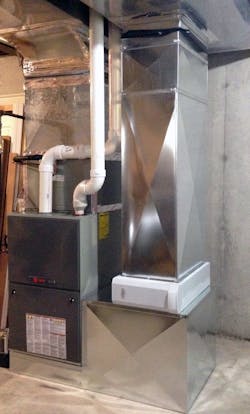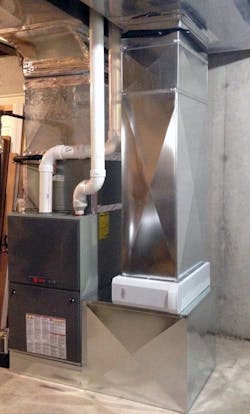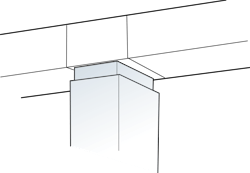Three Duct Upgrades to Improve Equipment Airflow
High-Performance HVAC professionals fix airflow problems. It’s one specialty that sets them apart from everyone else. One of the biggest challenges to correcting airflow problems is where to begin. What’s the first step?
There’s a tendency to think you must rip the entire duct system out and start over. Sometimes, that may be true. However, a simpler approach can improve airflow on many systems. Let’s look at three ways you can improve airflow issues at the air-handling equipment.
One: Increase Equipment Return Size
Getting air from a duct system into the air handling equipment is tough when the return drop/plenum is restrictive and/or poorly designed. Many contractors upgrade return duct fittings near the equipment to solve this problem.
On basement installations, it’s common to install bigger return drops with turning vanes or radius elbows. This option creates a smooth, low-pressure path for return airflow to enter air handling equipment.
Another gas furnace option is to raise the equipment and place a return box under it. The return box allows the blower to pull return air from one side and the bottom. Many distributors stock these pre-made return boxes for the furnaces they sell.
There are also times when the return drop size is correct, but it has restrictive duct transitions that kill airflow. A quick static pressureUndersized return plenums on horizontal equipment are also a source of airflow restriction. To improve airflow, consider increasing the plenum dimensions and using a centered transition so air easily enters the equipment.
A simple rule you can use is to size your return drops/plenums at .05-in. w.c. design friction rate on a duct calculator. This helps to keep noise and static pressure low.
Two: Increase Air Filter Surface Area
There is an epidemic in our industry of trying to cram more air through a filter than it can handle. It’s common to see five-ton equipment trying to pull all its return air through a 16 x 25 x 1 pleated filter.
Restrictive filters extend beyond the nasty, plugged-up examples many find in the field. A filter that is undersized, or installed in a poorly designed rack, can yield the same poor results. To discover this problem, measure static pressure drop across the filter – a visual inspection won’t cut it. If the filter pressure drop exceeds 20% of the equipment’s maximum rated TESP (total external static pressure), there’s a good chance the filter is too restrictive.
Upgrade your filtration systems to larger, less restrictive options to correct this problem. A filter that can handle required system airflow at 300 fpm (feet per minute) face velocity and a .10-in. w.c. pressure drop is a great choice.
An upgraded return drop also provides a great location to install a new filter assembly. Once you upgrade the filter, don’t forget to retest the filter pressure drop to ensure it’s acceptable.
Three: Improve Supply Plenum Design
Poor supply side fittings impact airflow the same way as bad return duct fittings. If you find questionable return duct fittings, chances are you’ll also find questionable supply duct fittings.
It’s common to find upflow equipment with the supply air tapped in the bottom of a four-foot section of trunk duct. This results in excessive turbulence and uneven air temperatures.
To correct this problem, you can remove the four-foot duct section and replace it with a supply plenum that has oversized takeoffs attached to the supply ducts. When you have limited space, consider installing a radius tee fitting in place of a supply plenum.
Know Your Limitations
As with any solution, there are usually limitations. The three duct upgrades mentioned here work wonders if the attached ducts can handle proper airflow. I have seen these three upgrades cut TESP in half and improve overall airflow and system performance.
However, if you have three-ton equipment connected to a one-ton duct system, there’s work needed beyond the equipment’s duct fittings. Look past the equipment connections and see to what they’re attached. Please email me for the one-page NCI Duct Design Tables and Quick Duct Capacity Check to help make this task faster and easier.
Capitalize on Existing Inventory
These upgrades use a combination of old-fashioned common sense and diagnostic measurements such as static pressure, velocity, and airflow. With some training, you can look at a duct fitting and see potential problems. Measurements back up your observations and provide additional diagnostic clues.
When you know how to address them, you can convert the old-school assumptions, rules of thumb, and poor craftsmanship that have plagued our industry for decades into additional income and satisfied customers.
Don’t assume the duct systems you’re attaching new equipment to work as intended. You could miss a chance to improve them and deliver a superior product. Pay attention to the duct system and provide installations that deliver what you promise.
David Richardson serves the HVAC industry as Director of Training for the National Comfort Institute, Inc. (NCI). NCI specializes in training that focuses on improving, measuring, and verifying HVAC and Building Performance.
If you’re an HVAC contractor or technician interested in learning more about improving your duct systems, contact David at ncilink.com/ContactMe or call 800-633-7058. NCI’s website www.nationalcomfortinstitute.com is full of free technical articles and downloads to help you improve your professionalism and strengthen your company.
About the Author
David Richardson
Director, technical curriculum
David Richardson serves the HVAC industry as director of technical curriculum at National Comfort Institute, Inc. (NCI), Avon, Ohio. NCI specializes in training that focuses on improving, measuring, and verifying HVAC and Building Performance.


